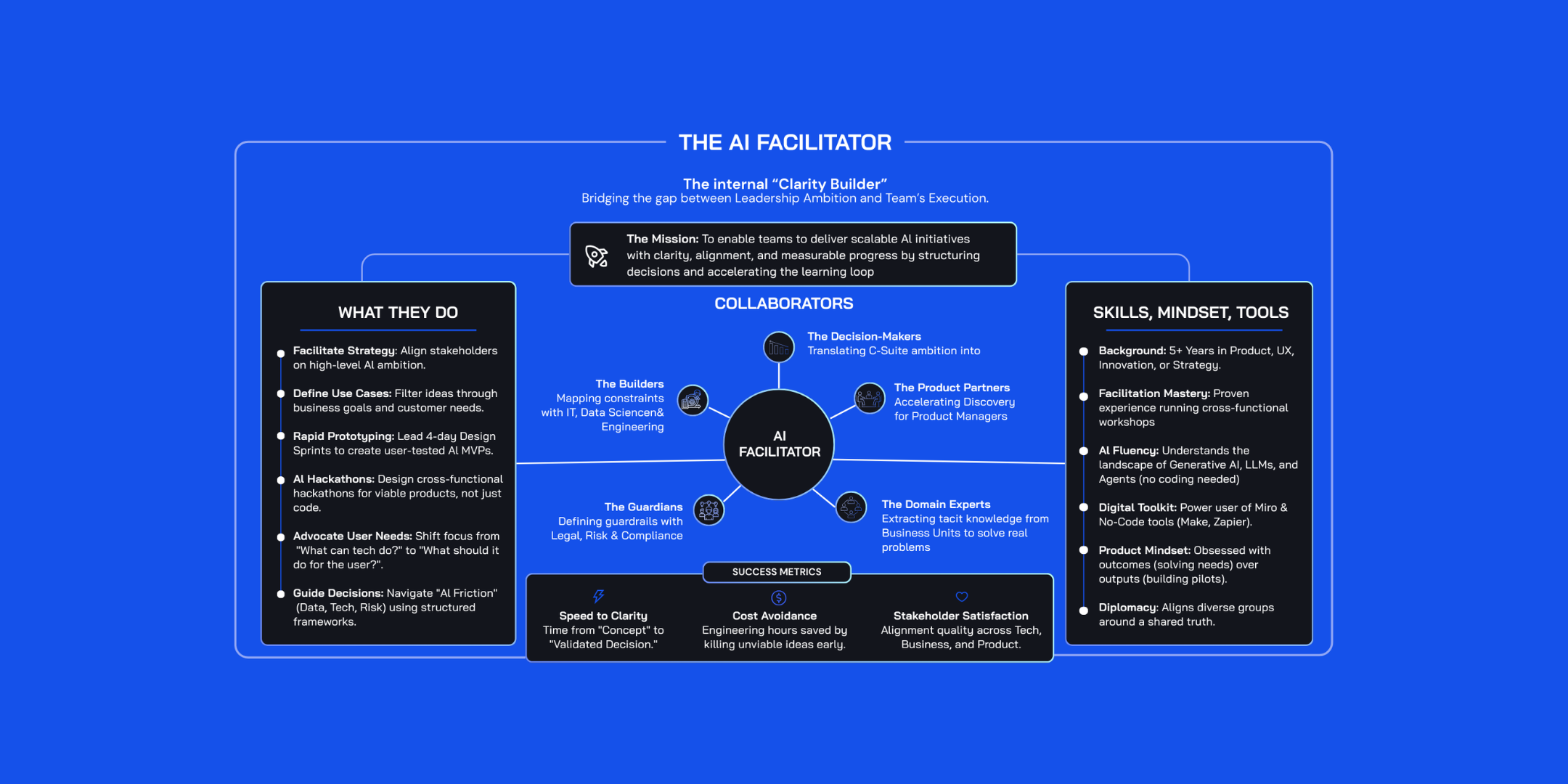Debunking Design Sprint myths: why they’re a powerful tool for large organizations

"Design Sprints are a terrible practice—focused on putting lipstick on the pig."
That’s what a product innovation leader recently told me.
When Design Sprint first hit the scene, it was a new approach that promised fast, impactful results. But like any tool, its effectiveness depends on how it’s used—and whether it’s adapted to fit real-world needs. For those who don’t know what a design sprint is, you can read this article.
So, honestly, I get the critique. The phrase captures what many think about Design Sprints: a shallow, rushed process that doesn’t deliver real value. While I disagree, I understand where these views come from.
There are common misconceptions about Design Sprints—about what they are, how they work, and what they’re meant to achieve.
Let’s address these critiques, one by one, and take a closer look at the reality of Design Sprints today—particularly how we’ve adapted them at Design Sprint Academy to make them work in complex, real-world environments.
❌ Misconception: Design Sprints Are for UX-specific tasks
"The notion of getting a large team from an organization in a room for five full days of workshops is ridiculous. And you can't get alignment on creating a button in five days."
✅ Reality: Design Sprints are intended to tackle complex, cross-functional challenges.
A Design Sprint isn’t about aligning on button designs or tweaking aesthetics—it’s about bringing together diverse expertise to solve big problems. At Design Sprint Academy, we avoid running sprints on narrow UX topics altogether. Designers have their own tools for those day-to-day tasks. A Design Sprint, on the other hand, focuses on big questions that require input from across the organization—from product and engineering to marketing and customer experience. It’s about breaking down silos and driving collaboration.
Examples of challenges solved with Design Sprints:
- Challenge: Optimize and standardize Live Operations processes to create a tool that enables lean operations for managers responsible for developing new content and in-game experiences.
- Client: A video game developer with 500 employees.
- Challenge: Conceptualize future innovations for a pump spray product line, envisioning 2023 and beyond. The goal was to develop strategic product initiatives across the portfolio to differentiate in a competitive, traditional market.
- Client: Industrial chemicals business with 40,000 employees
❌ Misconception: Sprints Don’t Work in Large Organizations
"Sprints may work at a tiny startup, but they’re difficult to implement in a massive organization."
✅ Reality: Design Sprints Can Be Adapted for Large Organizations
The original Design Sprint process wasn’t tailored for large enterprises. In my early experiences, I struggled to make it fit in those environments. That’s why we evolved our sprint methodology to better suit enterprise settings, with flexibility on the duration, team roles, and pre-sprint alignment. Today, we regularly run sprints in large organizations, adapted to fit complex, real-world dynamics. The results? Better alignment, faster decision-making, and a tangible outcome in less time.
Examples of enterprise adoption:
- Google: The birthplace of Design Sprints. In this webinar, Felix Wang, UX Lead at Google, discusses how sprints function within Google, covering success metrics, case studies, cadence, and more.
- SAP: Over two years, we helped SAP scale Design Sprints to foster a growth mindset among developers. Engaging over 400 employees and 45 strategic partners, these sprints generated 20+ new concepts. Read the full case study.
❌ Misconception: Design Sprints are Too Rigid and Prescriptive
"The five-day structure is overly prescriptive and does not fit the unique needs of every project or team."
✅ Reality: Structure with Flexibility
The real value of a Design Sprint lies in its structured framework for problem-solving—one that brings focus, alignment, and rapid decision-making. That’s a plus. But within that structure, there’s flexibility to adapt the process based on project needs. At Design Sprint Academy, we regularly customize our sprints, integrating pre-sprint research, customer journey mapping, or custom exercises depending on the challenge.This article shows how we changed the Design Sprint to allow for more flexibility within its structure.
❌ Misconception: Design Sprints Require Too Much Time and Resources
"Requiring a team to dedicate five full days is a challenge, especially for organizations with limited resources or busy schedules."
✅ Reality: Sprints Are a High-Impact Investment
Yes, dedicating five days can be a stretch. But in practice, we’ve refined the process to only require 2-3 days from core experts. Prototyping and testing can be handled by a smaller team, which reduces demands on the organization. And when you consider the alternative—endless meetings and drawn-out decision cycles that take weeks or months—a week (or less) to align on a major decision actually becomes an efficient use of time. In large organizations, time and resources are often lost to fragmented communication. A sprint, by contrast, is designed to streamline decision-making and reduce wasted effort.
❌ Misconception: Design Sprints are Overly Simplistic for Complex Problems
"While the framework is helpful for straightforward challenges, it can fall short for intricate problems requiring more detailed research and validation."
✅ Reality: Sprints Help Untangle Complex Problems
If anything, I find sprints particularly useful for complex problems. When done right, they bring clarity and focus to issues that can otherwise feel overwhelming. For more complex challenges, we often include research and problem framing as a pre-sprint activity, ensuring teams come into the sprint with a solid foundation of insights. This allows teams to focus on synthesis, ideation, and testing. The structured process of a sprint can clarify and prioritize complex issues, cutting through analysis paralysis and moving teams toward actionable solutions.
Our webinar “Embracing Design Sprint 3.0 for Large-Scale Innovation” covers how we tackle complex problems using Design Sprints, including real-life examples and a blueprint for implementing and scaling across the organization.
❌ Misconception: Design Sprints Lack Post-Sprint Guidance
"There’s little advice on what to do after the sprint ends, especially for further development and iteration."
✅ Reality: Post-Sprint Success Starts with Pre-Sprint Alignment
Effective post-sprint guidance begins before the sprint even starts. It requires clear alignment on purpose, executive support, and a roadmap for follow-through. Without these elements (which we capture in the Design Sprint Brief), a sprint can become a dead end. In cases where this alignment is lacking, we actually advise against running a sprint in the first place.
❌ Misconception: Design Sprints Are Too Product-Centric
"The Sprint book’s focus on product design limits its application in areas like business strategy or operations."
✅ Reality: Sprints Are Versatile Problem-Solving Tools
While product design is a natural fit, we’ve used Design Sprints across a wide range of applications—from manufacturing (like oil coolants) and retail to construction and healthcare. It’s worked for products, but also for service design and operational improvements. It’s a universal problem-solving framework that can benefit many areas of an organization.
❌ Misconception: Design Sprints Overemphasize UX and Design
"The sprint process leans heavily on UX and design, alienating team members in non-design roles."
✅ Reality: Design Sprints Rely on Cross-Functional Collaboration
In our approach, Design Sprints don’t focus exclusively on UX or design. Most participants aren’t from design roles at all; they’re subject matter experts from various functions who bring essential perspectives. This diversity is what makes a sprint effective—the best solutions emerge when different viewpoints come together. By involving engineers, marketers, and product managers alongside designers, we ensure that solutions are holistic and account for different perspectives—not just the design team’s.
For example, in October 2024, we ran three design sprints with a major construction company to create their first AI products. The team included engineers, project managers, and superintendents, with support from an AI coach—showcasing how essential subject matter expertise is to sprint success.
❌ Misconception: Design Sprints Don’t Account for Iteration Needs
"The lack of an iterative component limits the sprint, as feedback from testing often requires refinement."
✅ Reality: Sprints Lay the Foundation for Iteration and Execution
Iteration is essential, but it doesn’t have to happen within the sprint itself. A sprint is designed to provide an initial test of a concept, helping teams gain clarity and validation before investing more resources in refinement. After a sprint, feedback is integrated into a roadmap for ongoing development. The sprint serves as the initial building block, making future iteration more informed and focused.
After the sprint everyone can move forward effectively in their roles:
✔️Product managers can build a roadmap with confidence, knowing the team is aligned on the right problem.
✔️ Designers can shape the user experience, grounded in insights about real user needs.
✔️ Engineers can develop with clarity on what the solution does and the problems it solves.
❌ Misconception: Design Sprints Aren’t Scalable Across Large Organizations
"Large organizations with complex structures find the sprint model difficult to implement due to bureaucratic hurdles."
✅ Reality: Scalability Requires Organizational Alignment
Scaling any process in a large organization is challenging, and Design Sprints are no exception. But with the right support and alignment, they can be scaled effectively. We’ve helped many large companies embed Design Sprints into their workflows by training teams, securing executive buy-in, and creating playbooks for implementation. The challenge often lies not in the sprint itself, but in the organizational culture—sprints work best when there’s openness to cross-functional collaboration.
Example:
At RGA, a $20B insurance company, we helped establish an innovation framework based on Design Sprints, allowing them to scale sprints across teams on four continents. Read how RGA scaled sprints.
❌ Misconception: Design Sprints Lead to Fatigue and Burnout
"The sprint’s intense pace can lead to fatigue and burnout, especially if teams run multiple sprints consecutively. They are literally exhausting."
✅ Reality: Sprints Are Meant for Selective, High-Impact Problems
Design Sprints are indeed intense, which is why they should be used strategically. At Design Sprint Academy, we recommend running sprints quarterly or for particularly high-stakes initiatives. Instead of running sprints back-to-back, focusing on significant challenges helps prevent burnout and makes the sprint a powerful tool for creating momentum rather than fatigue.
❌ Misconception: Design Sprints Are Just a Trend for Consultants
"Design Sprints are just another trendy tool for consultants, often resulting in superficial, ineffective workshops."
✅ Reality: A Well-Run Sprint Is Transformative
Unfortunately, poorly executed sprints do happen. The solution is to carefully choose your Design Sprint facilitator or consultant, because not all sprints are equal. A well-run sprint, led by experienced facilitators, can drive real alignment and uncover actionable insights. But if it’s just about going through the motions, a poorly executed sprint will indeed be a waste of time.
Conclusion: Design Sprints as a Modern Problem-Solving Framework
Design Sprints aren’t about “putting lipstick on a pig”—they’re about solving problems in a fast, focused, and collaborative way. When adapted to fit the needs of real-world teams, they help break down silos, create alignment, and move projects forward with clarity.
So next time you hear someone dismiss Design Sprints as superficial, ask them this: Is the problem really with the sprint, or with how it’s being used?
Inspired to get started with design sprints? Have some questions? Ask our AI Design Sprint Master GPT! Get the link here and dive in!




.jpg)





